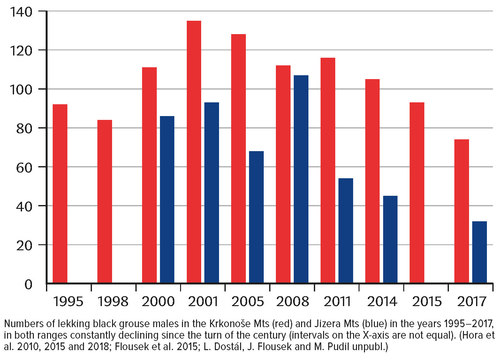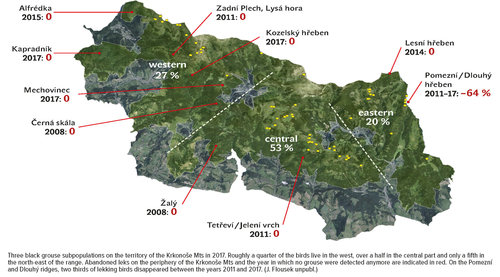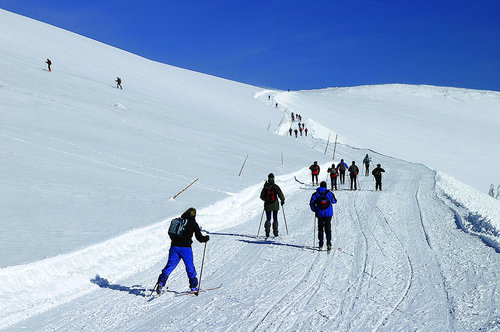Nature Conservation 2020 — 25. 3. 2020 — On Nature in the Czech Republic — Print article in pdf
Will the black grouse survive in the Krkonoše Mts until 2040?
For the time being, this is realistic! But it is up to us, the people who live and work in the Krkon
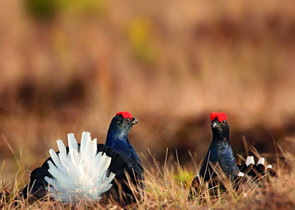
The Czech Republic probably does not have a more endangered species than the black grouse. The country hosts many birds which also face great problems and whose numbers are considerably lower than those of the black grouse, e.g. the little owl (Athene noctua) and the saker falcon (Falco cherrug). These have, however, a significant advantage as for survival: they manage to fly dozens or hundreds of kilometres and thus have at least a chance of finding suitable nesting grounds or new partners elsewhere, and mainly… they are within flying distance of their relatives in neighbouring countries.
The black grouse misses this advantage. The closest substantial populations can be found in the Alps, Scandinavia, eastern Poland and Belarus, i.e. many hundreds of kilometres away. Such a distance is an unsurpassable obstacle. The fact is that most males spend their whole lives within one kilometre of their hatching site, while females move away for up to 5 km on average, flights of over 10 km being an exception. An isolated population, especially when in trouble, is a fundamental problem for every animal, which is particularly true for ‘settled’ species like the black grouse. If we do not solve this bird’s problems ourselves, the surrounding nature will not help us. A strengthening of our populations with black grouse flying in from the Alps or northern Europe is namely impossible. And artificially increasing populations by releasing birds does not help!
Black grouse on the national level
Still in the mid-20th century, roughly 70 years ago, black grouse could be observed in most areas of the Czech Republic. During a national bird survey in the years 1973–1977 it was detected in only 15% of the original area, but its numbers were still rather high, estimated at 1,250–2,250 males (Šťastný et al. 1987). Then a dramatic decline followed: 800–1,000 males by the year 2000, less than 600 males counted in 2005 and only 330–380 males by the year 2017 (Šťastný et al. 2000, Hora et al. 2015, J. Flousek unpubl.). Within 40 years, thus 80% of black grouse have disappeared from our landscape!
The birds have vanished from all low-lying areas as well as the Vysočina region, the Jeseník Mts and the Bohemian Forest. Only three mountain populations have survived, in the Ore Mts, the Krkonoše and Jizera Mts, and the Šumava Mts and Boletice region. We cannot speak of populations in the Doupov Mts, where not more than 10 males live, nor the Libavá region, where two males only were found in 2018. In all areas, black grouse are still declining, the most dramatically in Šumava and at Boletice, seeing a decline of 95% in 40 years to the present number of about 50 males. The species is slightly better off in the Ore, Jizera and Krkonoše Mts, where it has declined by 40–60% since the year 2000 (see Box).
Why is it declining so fast?
There are many causes. The main one is the loss of suitable habitats and landscape fragmentation (e.g. Patthey et al. 2012, Geary et al. 2015). Black grouse prefer open habitats, especially waterlogged meadows, fens and peat bogs, heaths and clearings, with a rich herb layer, various Vaccinium species and scattered stands of Betula, Salix and Sorbus (the fruits of all these plants form an important component of their food) (e.g. Svobodová 2005). Another important condition is the presence of young woodland or shrubland patches in the vicinity, where black grouse hide and females build nests. This diverse mosaic of habitats should also include exposed sites with sparse vegetation or even without, where they dig up and collect small stones (grit), helping their stomachs to process food.
Such habitats have however disappeared from our landscape in a rapid way since the mid-20th century, as mentioned. Wet meadows have been drained, just as many lowland wetlands or peatbogs and waterlogged spruce forests in the mountains, and intensive farming has spread over originally unmanaged parts of the landscape. This has caused black grouse to decline more and more, and their formerly continuous population has shattered into small parts, leaving the birds only a few mountainous areas. However, they still do not have peace today. For example, the very valuable extensive bogs and open habitats in the Ore Mts, where currently nearly half of our black grouse population lives, are at the same time attractive sites for hundreds of wind farms planned there.
In the mountains on the border, particularly in the Ore, Jizera and Krkonoše Mts, affected by industrial air pollution in the late 20th century, the black grouse was one of the few bird species benefiting from forest dieback and the formation of large clearings (e.g. Šťastný & Bejček 1983, Flousek 1989). The emissions have fortunately decreased, the clearings are revegetating, and spruce forests are returning to sites where they used to grow – certainly a favourable trend, which however does not benefit the black grouse. The relatively untouched habitats beyond the upper treeline in the Krkonoše Mts are therefore all the more valuable.
Black grouse have accustomed to frequented tourist trails between Výrovka and the chapel in the Modré saddle, used by thousands of visitors. However, the two skiers on the left, selfishly preferring their own experience to vulnerable Krkonoše nature, are heading straight for the site of overwintering black grouse. Three more tracks in the same direction show that they are not the only ones. Grouse buried in the snow do not withstand this.
A very significant negative factor, probably the most important at least in the present Krkonoše Mts, is disturbance of black grouse at their lek sites, nesting sites and places where they overwinter by different, most often sport and recreation activities (e.g. Zeitler 2000, Baines & Richardson 2007, Arlettaz et al. 2013). In the current landscape we will hardly find places where man has not set foot, while the black grouse is very sensitive to any disturbance.
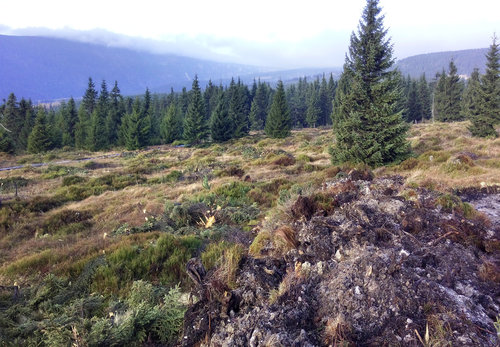
One of the created black grouse centres in the Krkonoše Mts including
an open area for lekking grouse, solitary trees or small tree groups
providing shelter to the birds, vegetation offering appropriate food
(blueberries, birches, rowans) and also an exposed patch for the collection
of grit. Photo Jiří Flousek.
Leks are a key area for the black grouse’s entire life and is the most important every spring. From late March to early May, a few hours after daybreak, males come together here, fight for females and the most successful ones mate with them (e.g. Alatalo et al. 1992, 1996). If the birds are disturbed, they fly away and when peace returns, they come back. If they are alarmed repeatedly, they only return the following day. And if such a situation, either disturbance by an early tourist, a supply car or a careless photographer, happens every day, this may cause the birds reproduction problems. In extreme cases, mating does not happen at all, so the female lays unfertilised eggs and the breeding of that year fails. One should realise that around 90% of females mate only once during the entire breeding period (e.g. Lebigre et al. 2007).
Winter is a critical time for the survival of black grouse (e.g. Patthey et al. 2008, Braunisch et al. 2011, Formenti et al. 2015). Most of the time they stay under the snow, into which they dig out burrows and have themselves covered by snow. Such an igloo protects them from unfavourable weather and from predators. They leave the burrows only in the morning and before the evening falls in order to collect food, thus replenishing their energy supply. Each extra time a black grouse leaves the burrows means a loss of energy, the necessity to spend more time on the snow when looking for additional food, and an increased risk of being predated by a beast or a bird of prey. By disturbing a grouse, also the stress hormone level in its blood rises. Stress is an important defence response of an organism to danger, essential for the survival of animals, including human beings. However, if it lasts long, it undermines the health of the stressed individual. A single disturbance of a black grouse increases the level of its stress hormone by 20–50%, while each other disturbance prolongs the time of its decomposition. Permanent stress causes grouse health problems, increasing the risk of being surprised by bad weather or a predator. Studies from the Alps clearly show that the stress level of black grouse rises with decreasing distance to a ski area or frequented cross-country trails.
The mentioned predation is a common feature in nature. If the population of a potential prey (a grouse in our case) is favourable, it can cope with predator attacks. However, if that is not the case, any caught bird or destroyed nest may be a concern. It is obvious that there are enough natural enemies of black grouse all around: the numbers of fox, wild boar and martens (especially beech martens) have long been increasing, and weasels and goshawks predate on black grouse as well (e.g. Summers et al. 2004, Tornberg et al. 2016).
Also ‘invisible’ obstacles, like cables of cable cars and ski lifts, electric wires and mesh fences protecting tree plantings, are a danger (e.g. Bevanger 1995, Baines & Andrew 2003, Buffet & Dumont-Dayot 2013). A brusquely flying black grouse cannot avoid them and after the collision it dies or gets wounded with a small chance of survival.
To date, we hardly know anything about the impact of the ongoing climate change (e.g. Spidsø et al. 1997, Selås et al. 2011). However, due to rising temperatures in the breeding time, hatching of the chicks will cease to overlap with the time of optimal food supply. Also the amount of natural snow will decrease and so black grouse are expected to get difficulties with building their winter shelters, while birds overwintering outside the snow cover are more vulnerable to weather and predators.
And what about Krkonoše?
No glory! During the last survey of lekking grouse in 2017, we counted 74 males (the inconspicuously coloured females cannot be counted exactly) on the Czech side of the mountain range. Sixteen years before, 135 males were observed lekking here, which means a decline of 45% (see the graph).
One of the characteristics of a black grouse population is the number of males lekking in a lek (e.g. Höglund & Stöhr 1996, Lebigre et al. 2007). The more birds are lekking together, the higher the chance that the best of them will mate with females and their genetically high quality offspring will maintain the population in a favourable condition. Conversely, in leks with one male only even a young or handicapped individual will assert itself. Also this is apparently a problem in the Krkonoše Mts: the last censuses of collectively lekking males ranged from 4 to 25%.
In contrast to the remaining Czech populations, black grouse in the Krkonoše Mts also have many advantages. Clearings created by air pollution revegetate also here but there are many mountain meadow enclaves and particularly habitats above the upper treeline which offer the black grouse living space. Moreover, the entire mountain range is protected as a national park, which is the highest nature conservation category in the country. Black grouse thus have ideal conditions for survival in the Krkonoše Mts with their national park, subalpine and alpine grasslands and peatbogs with scattered mountain pine (Pinus mugo) stands on their ridges.
Unfortunately, everything seems to be overshadowed by the area’s very high visit rate. The latest census in 2018 showed that nearly six million visitors spent some 12 million days of residence here (CE‑Traffic 2018). So even if just a small percentage of them does not follow the rules of the National Park (such as keeping to marked trails), there is probably no help for the grouse.
Is there anything we can do?
Certainly! Possible ways to solve the problems are given by the abovementioned list of problems with the black grouse. We can probably not return lost habitats to them, but we can preserve and try to connect the still remaining suitable ones. A total of 24 black grouse ‘centres’ with a total area of 86 hectares have been created in the Jizera and Krkonoše Mts in the last four years (Dostál & Kavková 2015, J. Flousek unpubl.). By cutting woodland, open areas have been formed for completely new or lost lek sites, moreover at flight distance in order to give at least grouse females a chance to fly from the Jizera to the Krkonoše Mts or back, or gradually ‘skip’ from the west to the east of the latter mountain range.
The mentioned invisible obstacles can be removed with a simple technical solution: securing cables of cableways and ski lifts with hangers deterring the birds (the FireFly type – www.hammarprodukter.com seems the most appropriate for the time being), and either building mesh fences no longer or securing them by visual elements (e.g. upper or lateral cross-bars).
Also disturbance of black grouse can be limited to an acceptable level. However, we cannot do here without a responsible attitude of every inhabitant and visitor of our mountain ranges. Black grouse can adapt to human movement along well-known routes. Any deviation from them is however a problem for the birds. And remember that in winter such a problem can be caused by just a few irresponsible individuals who enter inaccessible places left for a peaceful development of nature and its inhabitants.
There is no time to lose. We have some ten to twenty years to try and reverse the unfavourable population trend and maintain the black grouse in the Krkonoše and Jizera Mts as well as the rest of the Czech Republic in sufficient numbers, therewith preserving this fascinating and iconic bird species for the next generations!
A list of references is attached to the web version of the article at www.casopis.ochranaprirody.cz



